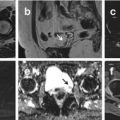and Jurgen J. Fütterer2, 3
(1)
Department of Radiological Sciences, Oncology and Pathology, Sapienza University of Rome, Rome, Italy
(2)
Department of Radiology and Nuclear Medicine, Radboudumc, Nijmegen, The Netherlands
(3)
MIRA Institute for Biomedical Technology and Technical Medicine, University of Twente, Enschede, The Netherlands
Abscess, Renal and Percutaneous Drainage of Kidney
Renal abscess is defined as a parenchymal fluid-filled mass of infectious origin containing suppurative material and delineated by a pseudocapsule. It is usually a sequela of acute renal infection, in particular pyelonephritis or bacterial nephritis, and although the inflammatory process is reversible, it can occasionally result in liquefactive necrosis and abscess formation.
CT: CT is the most accurate modality for the detection of renal abscess; it usually appears as a spherical mass with a thick wall; gas may be visible within the collection. After contrast administration, abscess wall enhances, whereas there is no central enhancement (“ring” sign or pseudocapsule) within the parenchyma surrounded by an area of hypoattenuating cortex at the nephrographic phase. Fascial and septal thickening are usually present. MRI: rim enhancement of masses >1 cm. The puncture and drainage of most abscesses can be performed with CT guidance. When the upper pole is involved, CT is indicated to avoid trauma to the spleen or pancreas.
A perinephric abscess may develop directly from acute pyelonephritis, but it can also result from rupture of a renal abscess into the perirenal space or from extension of inflammatory disease outside Gerota’s fascia; it can even involve iliopsoas muscles and extend to the pelvis.
Abscess, Prostatic
Prostate abscess is a closed pocket containing pus within the prostate. Predisposing factors for periprostatic or prostatic abscesses are diabetes mellitus, urethral catheterization or manipulation, and an immunocompromised status. Most abscesses are infected; any portion of the prostate can be involved and it can communicate with the urethra.
CT: CT can detect a prostatic abscess (single or multilocular area of low attenuation). Once diagnosed, it can be drained using endorectal US guidance, and a perineal or transurethral drainage approach can be used.
MRI: MR imaging is usually not performed for this condition, an abscess should be suspected when a cystic lesion with thickened walls, septa, or heterogeneous contents is seen in a patient with typical clinical finding T1W can show enlargement with or without a decrease in signal intensity. On T2W images, the abscess shows higher signal intensity than the adjacent peripheral zone. The postcontrast acquisition can show a typical peripheral strong enhancement.
Abscess, Tubo-ovarian
It is the term for a variety of infections that involve the fallopian tubes, the ovaries, and the surrounding tissues and often originates from pelvic inflammatory disease; other causes, less frequent, can be Crohn’s disease, diverticulitis, perforated appendicitis, and pelvic surgery.
Symptoms vary in large scale and may be atypical: lower abdominal pain, fever, elevated blood C-reactive protein level, and adnexal tenderness.
CT: The abscess manifests as bilateral thick-walled, fluid-filled adnexal masses. The abscess wall and adjacent soft tissue inflammation enhance intensely. Internal gas bubbles, which are unusual, are the most specific sign of an abscess.
MRI: Tubal enlargement can be easily seen on MRI images and is characterized by the tortuous folding of fluid-filled structures on T2-weighted images. Associated findings include thickening of the uterosacral ligaments, infiltration of the presacral fat secondary to edema, hydronephrosis, and indistinct margins of adjacent bowel loops.
Treatment classically consists of antibiotics or surgery (such as laparoscopy or laparotomy with drainage of the abscess, unilateral or bilateral adnexectomy, or hysterectomy).
Adenomyomatosis of the Uterus
It is a benign disease of the uterus, relatively common in women of reproductive age. It is characterized by the presence of ectopic endometrial tissue (glands and stroma) within the myometrium.
Most patients present with menorrhagia and dysmenorrhea. Three different forms may be identified: diffuse adenomyosis (most common form), focal adenomyosis/adenomyoma, and cystic adenomyosis.
MRI: MRI is the modality of choice for the diagnosis, with a very high sensitivity and specificity. On T2W sequences, it is indicated by an irregular thickening of the junctional zone of the myometrium, often containing some small high T2 signal regions, which correspond to islands of endometrial glands with cystic change or hemorrhage. After administration of contrast, it may show enhancement of the ectopic glands.
CT: CT is not routinely used as it is unable to diagnose adenomyomatosis.
Adnexal Torsion
It is an uncommon gynecological emergency, potentially lethal, that may occur in women of any age, but it is more common during reproductive age. It is the result of axial rotation of the ovary and/or the fallopian tube about its vascular pedicle; it is generally unilateral, with a slight right-sided predilection. This condition may be partial or total, and it can be intermittent or maintained. It causes severe lower abdominal and pelvic pain due to arterial and venous stasis; if untreated, the torsed ovary becomes hemorrhagic and often necrotic.
CT and MRI: CT and MRI may be useful when a sonogram is indeterminate. CT and MRI show an enlarged, usually edematous, or in some cases hemorrhagic ovary, with peripheral follicles; lack of enhancement may be seen. The involved ovary can assume a midline position; other common findings include a small amount of free fluid and engorgement of blood vessels. MRI is not the imaging modality of choice as urgent imaging is required; it demonstrates hyperintensity on both T1W and T2W sequences due to its edematous and hemorrhagic composition.
Stay updated, free articles. Join our Telegram channel

Full access? Get Clinical Tree




